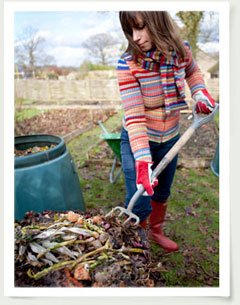
Easy garden composting (for lazy gardeners)
Posted in Healthy Home & Pets on June 1, 2012. Last modified on April 25, 2019. Read disclaimer.
Many people believe that composting is strenuous and takes a lot of time. In reality composting can be very simple, costs nothing, and can be done in just minutes a day. Composting can be divided into 3 basics types: worm, hot, and cold. Composting makes decomposing material become active organic matter. Finished compost provides the bacteria, nutrients, and enzymes required for plants to thrive.
Worm composting
Properly called vermaculture, this is where worms are used to break down materials such as cardboard, newspaper, and food scraps into fine dark black soil. This soil is mineral rich and full of healthy microbes providing excellent fertilizer for any plant. The worms, typically red wigglers, eat the leftovers and speed the natural decomposition process. Perhaps best of all, worm composting is easy -- the whole process can be done inside the house in a bin!
+ Free Shipping & Returns on Eligible Items.
(*Amazon's Top 100 list updated hourly.)
Hot and cold composting
These two methods utilize the same materials, wet and dry organic matter such as grass, leaves, paper, and food scraps. Most commonly the compost is "aerobic" meaning the microbes need air to survive. "Anaerobic" compost is made predominately of animal wastes and is only good for specific plant types. For lazy compost, open air aerobic compost either hot or cold is ideal.
Hot compost is when the materials are heated to cause them to decompose quickly. Compost tumblers are black round bins that can be turned round to mix the materials. Some cost effective folks use a pit-like hole in a sunny area of the yard covered by black sheeting and turned with a pitch fork. The main premise behind hot compost is to use the sun, moisture, and turning to increase the heat, speeding the decomposition. Hot compost well maintained can create black soil in a matter of weeks. While it is not extremely time or labor intensive, hot compost demands a mix of brown (dead leaves, paper) and green materials (table scraps, grass clippings) in an approximate 50/50 ratio. The upside is that the soil has more nitrogen than cold compost. Nitrogen is required for soil fertility and is the base of most commercial fertilizers. For the truly lazy, having compost in a short time frame is not worth the extra energy.
Cold compost is ultra low maintenance. Food scraps, grass trimmings, and leaves are tossed into an open hole or simply a designated area of the yard. To keep pets and people out of the process, spend one day building a raised bed like holding box. At least once a day take the trimmings and organic waste to the compost, dump it in and forget it. It will decompose slowly all on its own accord. Nature has a mechanism of dealing with waste and doesn't require much help or intervention. Cold compost is often chosen due to the greater microbial diversity. For best results, long cure the compost in the sun before adding to the garden. Layered compost is the lazy gardener's best friend and is super easy to do with no mixing and no turning at all. You create a walled storage box and put down burlap sacks between layers of waste. Nothing more is required. A big bonus is that you don't have to wait until the compost is complete decomposed to plant your vegetables. You can plant peas, beans, potatoes, and squash and get right to the fun part.
Laziness often causes people to forget to take out their compost on a daily basis. If it goes more than a few days bugs, mold and potentially dangerous bacteria will be growing in the kitchen. A simple solution is to temporarily store "kitchen products headed for the compost bin" in the freezer. That way there is no smell or bacteria growth until the scraps get outside.
Compost all available and appropriate materials. Cardboard and paper are great if you break them down into small pieces. Chopping and mixing different types of waste speeds up the disintegration process. You can throw your weeds directly in the compost pile. Manure from vegetarian animals is a perfect addition to compost, but be sure it has integrated well to the mixture to avoid disease. Meat, dairy, and citrus are the few edible scraps that should NOT be composted. Also manure from omnivorous animals such as dogs, cats, and humans are a no go. These materials slow the decomposition process and lead to rotting. This can be a breeding ground for the wrong kinds of bacteria.
Two things compost needs to flourish are air and water. Water your compost pile like an ugly but prized flower. Be careful not to overwater or underwater. Watering once a week is about right for most locations. If it rains heavily and your compost is open, nature has done the work. Compost likes air hence why it should be turned. By letting the air flow, it helps to feed the good bacteria and microbes. This is the one semi-labor intensive step but only needs done periodically and depending on the size of your compost pile should take around 30 minutes.
Three common compost issues that are easy to fix are if it gets smelly, has maggots, or ants. If it gets smelly add more dry materials like leaves or pine needles to absorb the odor. These are referred to as brown materials. If there are many maggots and some unwanted guests add a layer of dirt this will kill some of the pests and gives the compost more balance. If you get ants, your compost is too dry and you should add some water. Regular maintenance will keep your compost pile healthy and active.
Compost is a simple and easy way to get great yield in your garden. By planting a garden you increase your family's food security and reduce food expense. With very minimal effort and investment, you can enjoy a stronger connection to your food and to the planet. With all of the benefits of compost, why not start today?
How to compost with worms (vermaculture)
from Mother Earth News
- First, make your own worm bin by drilling around 30 holes around all sides of a 10- to 15-gallon plastic storage bin. The holes allow the worms to breathe as air is required for them to eat the compost. Some people chose to buy worm bins but they are expensive and this is super easy and almost free.
- Half fill the bin with newspaper and/or unwaxed cardboard and add some water to make it damp. Because worms need sand-like gritty soil for their gizzards to digest food (your compost), start your compost factory with 1 pint of compost and 1 cup of plain cornmeal.
- Red wiggler worms are low cost and can be added immediately. Another suggestion if you don't want to buy worms is to harvest them from a garden. (See Comments section below, discussing the "red wigglers vs garden worms for composting" debate.)
 To keep the worms inside the bin rather than in your house, secure the lid. Worms like cool places so put the bin somewhere like the basement where the temperate is 55 and 75 degrees.
To keep the worms inside the bin rather than in your house, secure the lid. Worms like cool places so put the bin somewhere like the basement where the temperate is 55 and 75 degrees. - Add food scraps daily, burying them in small piles in different locations in the bin. The worms will work through the piles and putting it in several locations encourages them to move throughout the whole bin.
- After a few weeks it will be time to start to harvest your vermicompost reward. Reach to the very bottom of the bin and scoop out a few handfuls of compost and stick it in the sun. The sun makes all the worms move to the bottom of the pile. Then collect the vermicompost from the top and viola. Then return the worms to the bin to continue their work and keep eating!
Sources (Accessed June 1, 2012)
http://www.motherearthnews.com/Organic-Gardening/2006-10-01/Compost-Made-Easy.aspx
http://jeannegrunert.hubpages.com/hub/The-Lazy-Gardeners-Guide-to-Organic-Gardening
http://www.squidoo.com/easycompost
http://supak.com/mort/compost.htm
http://easycomposting.com/5-reasons-to-compost
http://www.rivenrock.com/composttypes.htm

 Childrens health mini-quiz
Childrens health mini-quiz Where has all my energy gone?!
Where has all my energy gone?! Importance of eating probiotics
Importance of eating probiotics Diabetes causes & management
Diabetes causes & management 15 Tips for getting refreshing sleep
15 Tips for getting refreshing sleep How sweets effect health and aging
How sweets effect health and aging CDC's recommended vaccinations
CDC's recommended vaccinations Natural flea control for pets
Natural flea control for pets Guide to composting scraps
Guide to composting scraps Tips for early vegetable gardening
Tips for early vegetable gardening